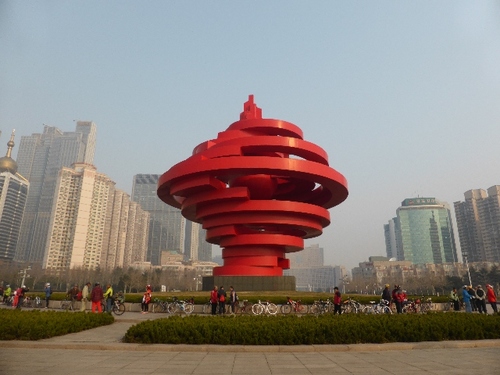Out of China: How the Chinese Ended the Era of Domination by Robert Bickers. Available in hardcover from Harvard University Press, 2017 and in paperback from, Penguin Random House UK 2018.
The subtitle of Professor Robert Bickers (University of Bristol, UK) personal web page reads: “History, empire, China, and things found on the way.” This adequately describes the wide-ranging material he covers in his most recent book Out of China: How the Chinese Ended the Era of Domination. While certainly not a book for the faint-hearted in terms of breadth and detail; it is definitely for those with an interest in China’s modern history both as it played out and in how it has been variously understood and portrayed. As the Financial Times’ reviewer, Julian Gewirtz, commented, the book serves as an important reminder of “uncovering the past’s messy contradictory truths.”
Bickers looks at how Western views about China were formed and consolidated. He also traces how Mao developed his own position: “pairing of ‘old’ and ‘new’ became the template into which was stamped every sphere of life” (page 291). “Truths” were interpreted in different ways. The past was “used” to promote and demolish alternative interpretations. Likewise the “old” was employed to validate the “new” as a New China stood up.
In the past couple of years, anyone with an interest in China will have noted a resurgence in nationalism which Bickers shows is firmly grounded in memories of—and a sustained, relayed narrative of—a degraded past. The relationship with Western powers is viewed through the “prism” of imperialism. This naturally clashed with the emerging Communist ideology and nationalist Chinese views of the 1920s onwards.
Imperialism and the associated Western domination were most clearly expressed and felt through the extra-territoriality clauses following two Opium Wars (1849, 1860) that Bickers shows being dismantled. He writes in vivid detail of the gradual movement of Western powers out of China and the New China’s exertions to establish itself with head held high as independent, self-sufficient and strong—a force rightly to be reckoned with in the 21st century.
In this book, he builds on his earlier book, The Scramble for China, which covered the period 1832-1914. He continues the history of multiple foreign presences into the modern period with the related issues of national and individual dignity as well as the mixed response to “things Western.” He traces how the New China post-Liberation from 1949 sought to fashion China’s identity. The roles of both imperialism and anti-imperialism are undoubtedly a distinctive part in the history of China that need to be remembered by those outside of China—because they most certainly are within China. Although China was never technically anybody’s empire, the treaty ports with land parceled out among different nationalities (most noticeably in Tientsin/Tianjin), often operated as imperial enclaves and foreigners living in them often held pronounced imperial attitudes.
The end of the First World War was celebrated in distant China and there was an air of promise. Cities experienced an economic boom that fostered social and cultural change evidenced in clothing, entertainment, and patterns of consumption. The postal services, expanded railway systems, and shipping lines ensured these changes moved inland.
Chinese delegates in Paris (Treaty of Versailles), talented and articulate, hoped this heralded a review of existing international relations and the foreign presence in their country. Instead they found imperialism was widely endorsed as Japanese claims to parts of China were accepted.
Demonstrations ensued in Paris and China, culminating in the May Fourth Protest Movement. Japanese goods and firms were boycotted—a strategy still used in more recent protests against foreign countries involved in China. New forms of political and social mobilization in the form of strikes, labor unions, and propaganda teams emerged. These fed into foreign perceptions and fears. Every gathering seemed a potential “mob” to be firmly, fiercely, forcefully quelled. Relationships became inflamed and anti-foreign feeling fuelled. Chinese nationalism and foreign imperialism came head-to-head.

4 May Protest Movement Memorial in Qingdao.
Bickers shifts from the cities to the countryside where 80% of the Chinese population lived (chapter 3). He points out that widespread generalizations about these areas as being blighted by poverty and national disaster, overlooked differences in scale and place. Then, as today, what is true for one place is seldom true for everywhere.
The Comintern[1]-Guomindang alliance began to consider possibilities of rural revolution. The missionaries, who were the most obvious foreign presence in the rural areas, reported about the harshness of country life and conducted surveys of the communities. Among them, differences in approach were developing with the use of the “Social Gospel” in which social welfare initiatives were increasingly promoted. Christians had to be seen as “adding value.” It was at this time that the YMCA embarked on the Mass Education Movement led by James Yen and espousing autonomous Chinese Christian expressions. Substantive changes were made regarding foreign-run schools and colleges (from 1928 on).
The Nationalist forces moved to reclaim the foreign concessions bit by bit, extending their control so that there really was a new dispensation in China. The country’s sovereignty and pride was to be restored. They faced the challenges this involved in practice as well as the engrained contempt for China taking hold in the foreign mind (chapter 5).
Another foreign presence makes its entrance with the USSR (chapter 8) among the foreign experts that sought to “solve the problem that was China.” On the withdrawal of the Russians in 1960, the notion of a New China was communicated through another bevy of foreigners who were eagerly fêted in order to tell the wider world about China’s reconstruction, and the central role of the peasantry in driving it. The stories of land reform and liberalization of women were popularized in a carefully controlled manner showing “the wonderland beyond the wall.” An “eclectic cadre of foreign nationals,” usually with Leftist leanings, not only wrote publications but also assisted with the growing number of visiting delegations as the government entered a period of cultural diplomacy (chapter 9). The visitors came but did not see the realities of the disastrous Great Leap, or ramifications of the personality cult taking hold. Bickers notes how “one caricature” of China was largely substituted for another.
Then came the descent into chaos on an unimaginable scale as Red Guards with sanction from the very top, continued the revolution and mercilessly attacked China’s cosmopolitan centers that were permeated through with foreign influences (chapter 10).
China’s isolation gradually changed with the “ping-pong diplomacy” (or “panda diplomacy”?) of the 1970s. The USA sought to re-establish relations, while juggling those with Taiwan. Britain wanted to overlook the past “uneven” relationship. They had the unfinished business of Hong Kong to manage, failing to really grasp the extent to which “humiliation” remained a backdrop. Some Japanese admitted to their atrocities in China while others whitewashed them. More foreign visitors came as the country opened up, and many sites of pilgrimage and commemoration were established (as has been happening in recent years) to refresh the historical memory of the people.
Bickers concludes with an acknowledgement that China’s past has seen much to inspire rage at the ugly foreigner, but that far too simply overlooks the immense suffering of the nation after the withdrawal of these foreigners. There is also the subtle shift from decrying colonialism with the cosmopolitanism it espoused to commending a fresh cosmopolitanism seen as a culmination of China’s impressive achievements. Bickers concludes: “The China dream is grounded in this story of an unrelenting Chinese nightmare. We need to acknowledge that, and understand it, but we do not need to believe it” (page 407).
The complexity leaves a layering of history that raises the question expressing a China dilemma: “So what do we believe?” Between his concluding line and the exhaustive Notes section, are a valuable couple of pages simply titled, “Further Reading, Watching and Listening”. It is a very helpful resource and a reminder that one dare not approach China without having done one’s history homework! It is also no simple matter of cramming facts but rather being sensitized to the complexities before personally working at an answer as to what one will believe.
Source: Robert Bickers: History, empire, China, and things found on the way.
Text image credit: A. Klopper, 2014.

Andrea Klopper
Andrea Klopper has taught in South Africa, the United Kingdom, and China. She has mentored Mandarin language students and developed a cultural orientation and acquisition program which she used in two organizations. She is now being challenged to make friends in a new location and learning a new language. She …View Full Bio
Are you enjoying a cup of good coffee or fragrant tea while reading the latest ChinaSource post? Consider donating the cost of that “cuppa” to support our content so we can continue to serve you with the latest on Christianity in China.

